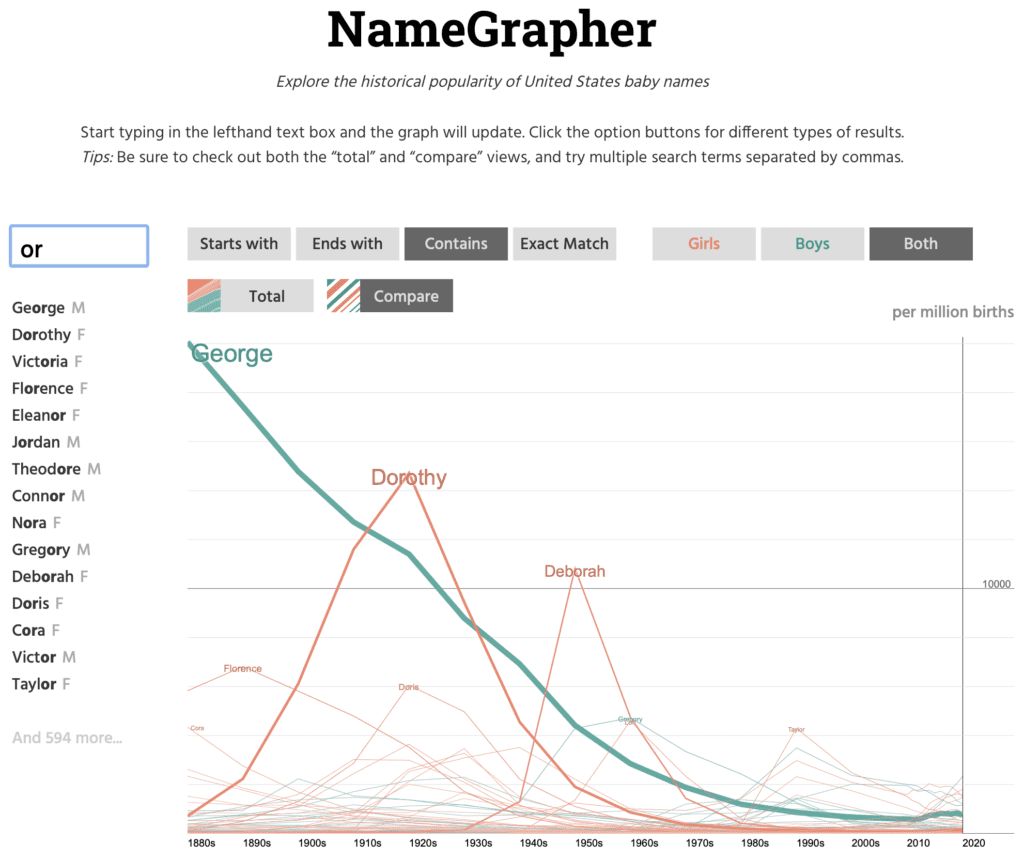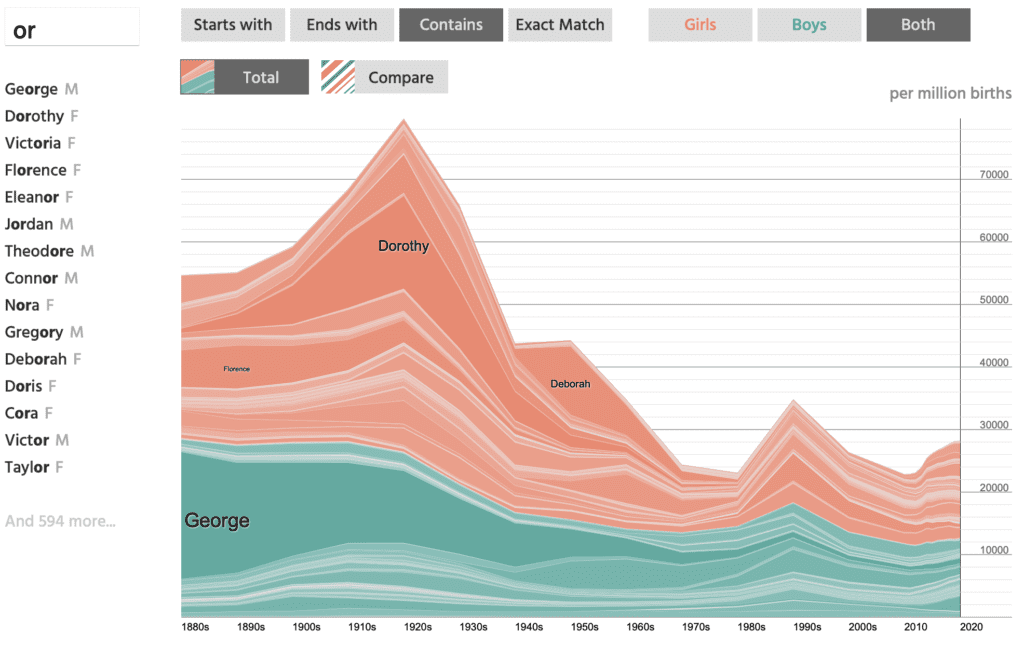
Laura and Martin Wattenberg point us to NameGrapher, a fun tool for exploring historical trends in baby names. Above are the time series of the most popular names with “or” in them. You can also do the first letter or first few letters of the name, or the last letter or the last few letters. And when you type in new names the graph changes dynamically.
You can also plot totals, which more clearly shows the differences over time for girl and boy names.

It’s good to be reminded that no single display will do it all: different views of the data will reveal different things.
I think the data come from the Social Security database, and I guess the Social Security people or someobody else did some preprocessing so the numbers line up with year or decade of birth.
Just one minor thing: I think the x-axis needs to be fixed in that the decade numbers don’t quite line up with the axis. The data for 2010 onward are yearly; before 2010 they’re by decade. But then I think the data for the decades 2000-2010, 1990-2000, etc., should be plotted at 2005, 1995, etc. As it is, the point for each decade is displayed to the left of the decade marker, thus visually assigning 2000-2010, 1990-2000, etc., to the years 2000, 2010, etc. No big deal but they could do better. Also, I’m not colorblind so I can’t say, but this green and orange palate . . . does it work for everyone? I have no idea.
Anyway, what I really want to say is that this NameGrapher tool is wonderful. It’s an updated version of the Baby Name Voyager, one of our favorite interactive graphics.
Laura Wattenberg also has restarted her baby name blog, and that’s great. We’ve appreciated it in the past.
This is great. The first thing I did was look for boy names ending with “aden” and had my suspicion confirmed graphically.
Love me some of that Chris Rock effect.
I’m not colorblind, but “palette” instead of “palate” works better for me.
Ethan:
This is an amusing example of linguistic convergence. Palette is indeed correct, and my above use of “palate” was a mistake. But I can see how the mistake happened, in that “palate” is all about taste, and I was talking about my taste in color palettes.
So synesthesia .
Just for the heck of it, I typed in “Martha”, and noted that the popularity of the name went into a steep decline for quite a while after I was born.
Coincidence?
In contrast, mine skyrocketed shortly after I was born. Just sayin’
Martha’s still doing much better than Bertha, Edna, and some other grandma-style names.
It’s fascinating. Seems like it could make for lots o’ fun statistics. Is the pattern just purely random or can there be some kind of underlying mechanism of popularization deciphered? What does it tell us about group psychology? Get on that, will you?
I’m really late to this party, but I’d think fashion with a genesis in celebrity plays a key role. I’m Gen X, born 77, and Martha was a popular choice among my age group for their daughters. Both Martha Plimpton and Martha Wainwright were pretty ‘cool’ figures in pop culture in the 90s, whereas there were no comparable Berthas or Ednas! Followed up with the fad for Americana over the last 15 years or so, it’s had steady support.
I also noticed the monumental emergence of Ava after Reese Witherspoon & Ryan Phillippe (USA) chose it for their daughter in 1999. This was followed by a boost from Lleyton & Bec Hewitt (Australia) in 2010. I don’t really mind it as a name, but I do blame them for its painful ubiquity!
name “Unknown” peaked in the 1940s-1950s. odd, since there are so many of them out there.
Not a single baby was named Anonymous (or anything containing “Anon”). I guess that means all such commentators on this blog come from other countries.
Dale:
I think these data only include names that occurred at least 5 times in a year.
I didn’t use your source so it might differ. But my name list shows all names each year that are used at least once. If it were restricted to those with at least 5 times/year, it would be a more interesting inferential problem to compare commentators with the list. But on my name list “anon” has never been used, in whole or in part.
I find it implausible there isn’t at least one baby named Qanon or similar.
In fairness, my data set is 2 or 3 years old, so Qanon was not there. It might be now.
My data runs from 1910 through 1917. Indeed no names include “Anon.” Also there are none named “Nostradamus” and only six babies names include “Darth,” and those were either Dartha or Darthy. Also, 45 babies in the US were named “Adolf” but none after 1940. Frankly, I am amazed parents seem to show as much sense as this.
I like that you can enter multiple names separated by commas, the more easily to compare Nevaeh (“heaven” spelled backwards) to the less-popular-but-still-ranked Neveah (“heaven” misspelled backwards).
I find it so amusing that one of few websites I regularly visit now, but was unaware of at the time I was naming my kids (15 and 10), has more than a few posts about one of the websites I visited frequently when I was trying to name those kids. How much time I killed when I should have been writing a thesis/dissertation (one for each kid!).
My favorite fact gleaned from that site way back when was pointing out that the prevalence of the current most common names were much lower than the names that were most popular when I was a kid, so even if you picked the most popular name it wouldn’t be Mike or Jennifer level of usage (so popular that even a last initial wasn’t enough to distinguish them in some classes.) And that stacked chart would let you see how common the name was if you combined it with all it’s very similar counterparts with alternate endings/spellings.
And the color palette is basically the same.